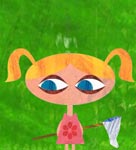 We'd worked together since 1991, but didn't begin our formal partnership until the beginning of September 1998. Our venture remained unnamed until mid-October. 'Blister' was not our first choice, but in fact our seventh choice. It seemed that no matter what eclectic name we thought up, someone somewhere already had a music production studio with the same name. Legal fees related to formal trademark searches were draining a tidy hole in our launch budget. Eventually we came to a point of exasperation, where it was like, let's just use the first thing available.
We'd worked together since 1991, but didn't begin our formal partnership until the beginning of September 1998. Our venture remained unnamed until mid-October. 'Blister' was not our first choice, but in fact our seventh choice. It seemed that no matter what eclectic name we thought up, someone somewhere already had a music production studio with the same name. Legal fees related to formal trademark searches were draining a tidy hole in our launch budget. Eventually we came to a point of exasperation, where it was like, let's just use the first thing available. If I had to do it over again, I would have gone into business with our first choice and simply waited for a cease and desist letter to arrive from an offended party. That way, we could have hit the ground running faster and had a little more cash in our pocket when we did –and honestly, I think it would 100% have been cheaper.
We founded our business with a mission to become the Interactive medium's premier audio supplier –delivering not just sound, as was typical for audio shops, but the applicable coding to insure the highest quality integration and playback. In the spirit of the burgeoning dot com age, we added the identifier 'Media'.
Other shops provided 'Recording', 'Mixing', 'Music', 'Music and Sound Design', or simply 'Audio'. I knew we were different because I knew our approach to the process was different. Dramatically so. There wasn't another commercial shop I could think of that considered the issues programmers faced during the construction of these new Interactive experiences.
In fact, there were only two other ventures I could find in those early days that could describe themselves as independent audio production studios defining themselves as leaders in interactive entertainment and the new emerging Internet economy. One was Cathryn Ramin's Team Audio project out of San Francisco, whose roster of talent included Ron Ramin and X-Files composer Mark Snow, and the other was Team Fat, a game audio collective led by George Sanger out of Austin.
Team Audio and Team Fat, and then Michael and I at Blister, –all three little boutiques who had figured something out before anyone else had, and in my mind were now racing to corner the market for interactive audio asset production.
I did not think the market was yet big enough for the three of us, so Ramin's and Sanger's ventures made me feel a bit like Lex Luthor from our studio penthouse in New York City. H'm, how best to defeat these two teams whose combined roster read like a league of legends. If I had been smarter, I might have suggested a collaboration, which no doubt would have led to partnerships and eventual world domination by Fat Blistering Audio today.
Either way, I still thought, 'We're in darn good company!"
At any rate, I'd like to believe that I brought to the table an understanding of market considerations coupled with an ear for maximizing the entertainment value of any given sonic experience, and Michael was a master of interactive composition, and in a pre-mp3 standard world, he had a magical way with compression that insured our audio sounded super streaming off the web.
As for branding, I wanted our message to indicate we carved beauty from chaos. I wanted to say 'disciplined but experimental'. I wanted to signal to our Madison Alley (Madison Ave + Silicon V/Alley, i.e. the ad tech community)neighbors that we were one of them, and not simply a place where bands just hung out and made demos, or the same kind of tired old studio that churned out dittys out of million dollar rooms. We were digital audio pioneers and we were one step ahead of the pack in understanding that interactive game audio techniques were essential to the next wave on advertising and entertainment assets. We eventually settled on the tag 'Music Noise Code'.
I love language as much as I love music –both are different manifestations of communicable sound– that memorable branding and marketing strike my ear as linguistic melodies.
Of course, I was quite pleased that when Mix Magazine's Internet Audio supplement published their April 2001 story about us (Interactive Composition Comes of Age), they even used the tag as section headers to tell three aspects of our story: Music, Noise and Code.
Blister Media – Music. Noise. Code
I still think it rocks.

